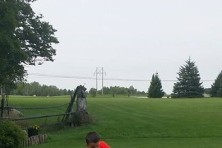Schmelzer Adds Challenges at 27 Pines
- Share
- Tweet
- Pin
- Share

Tom Schmelzer, the creator and owner of 27 Pines golf course, put in extra hours in May operating excavating equipment and tractors to build a new fairway bunker and pothole pond along two of the nine fairways. He’s continued to add features to the course and worked to improve greens every year, and this year he’s adding features along two fairways that had no obstacles whatsoever.
Schmelzer said he needed sod and soil to lengthen a tee box on the 195-yard ninth hole, so he scraped away a swath of ground to the left of the fairway and added a bunker. He says it will be the type of waste bunker where golfers can legally ground their club at address if they’re playing by the rules of golf.
In addition, Schmelzer dug a small, round pothole pond about 20 yards short and to the right of the fourth green. So, visitors who smother and top a drive on the ninth hole or hit a weak slice on the fourth will get punished a little bit by the hazards.
“You’re not supposed to be over there anyway,” Schmelzer said, offering golfers advice to avoid penalty strokes.
More from Former Caddies
Interviews with former caddies produced much more information than could fit in the May 19 Peninsula Pulse Fairways article.
This reporter occasionally asks older golfers with incredibly smooth swings and accurate drives whether they ever caddied. When asked whether he was ever a caddie, octogenarian and sweet-swinging former Horseshoe Bay competitor Tony Arzich said, “Yeah. I caddied for Al Capone’s former bodyguard. He was, like, six-foot-five and had hands twice as big as mine.”
Arzich, who works with the Alpine crew, grew up in Burnham: “the first town south of Chicago.” At about age 10, he caddied at Burnham Woods. Capone played there in the 1920s, and some of his colleagues still played there many years after.
Two former Peninsula State Park Golf Course caddies interviewed for the May 19 piece said they observed which equipment the good players used and which equipment the mediocre players used. As a result, both Don Ray and Doug Van Vorous said they always used high-quality equipment.
Van Vorous said the top players who had money to spend played Spalding balls, and the others used lower-quality balls or Acushnet Club Specials (from the company that made Titleists its high-end ball). Ray took it a step further and said the best golfers – or those with the deepest pockets – played the Spalding Dot, and the cash-strapped players, beginners and park campers used Po-Dos.
Advertisements in the mid-20th century told golfers that the Dot ball and best Titleists were sold by golf professionals only. Meanwhile, Walgreens sold Po-Dos for less than a dollar per sleeve. Po-Do was named after Peau Doux, the late Charles Walgreen’s Boston terrier, the Chicago Tribune reported in 1998.
Appropriately enough, the ball was a real dog. In modern terms, think Titleist Pro V1 ($55 per dozen, on sale) versus Nitro Ultimate Distance (still as low as $6.99 per dozen, or $35 for a 45-pack).



